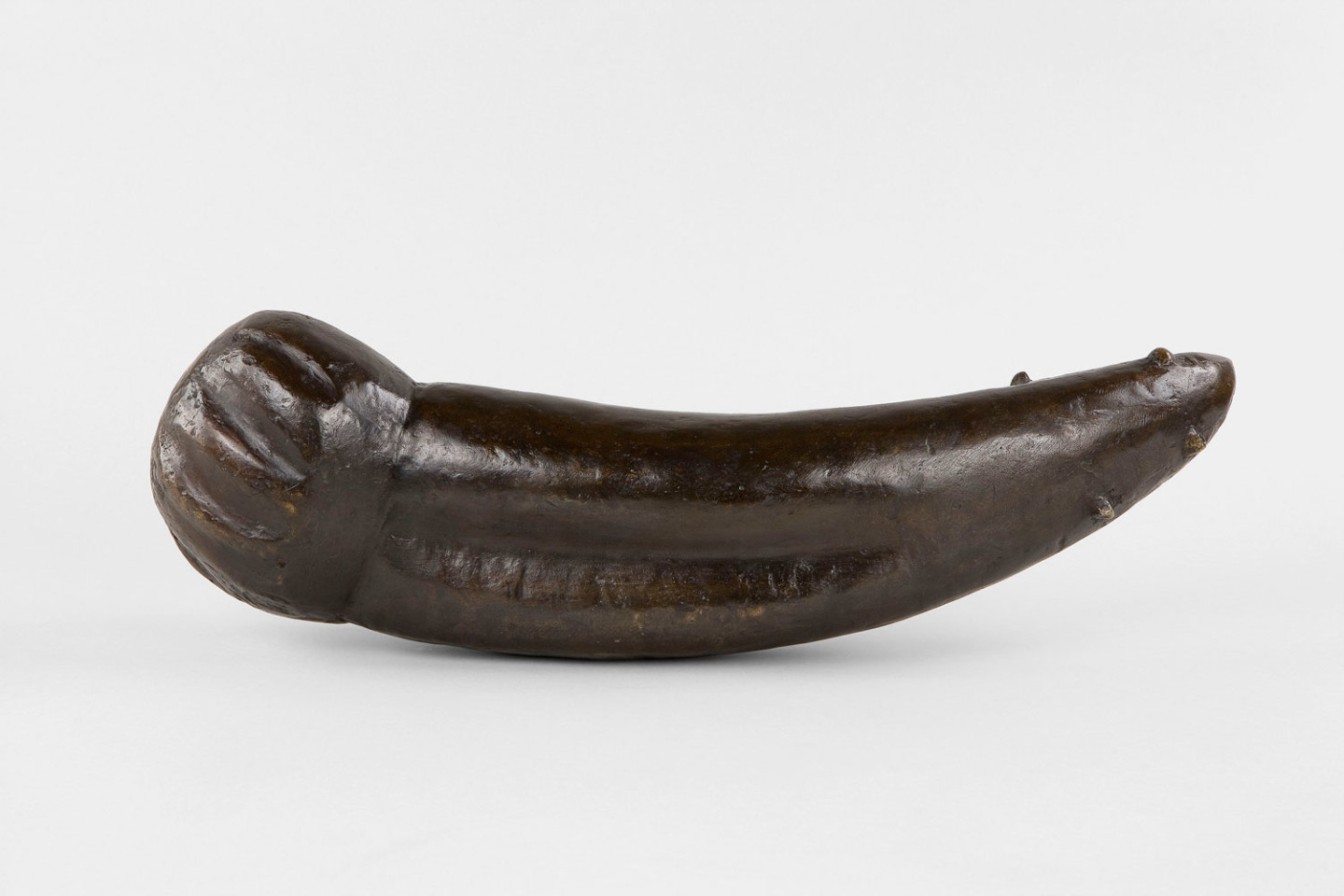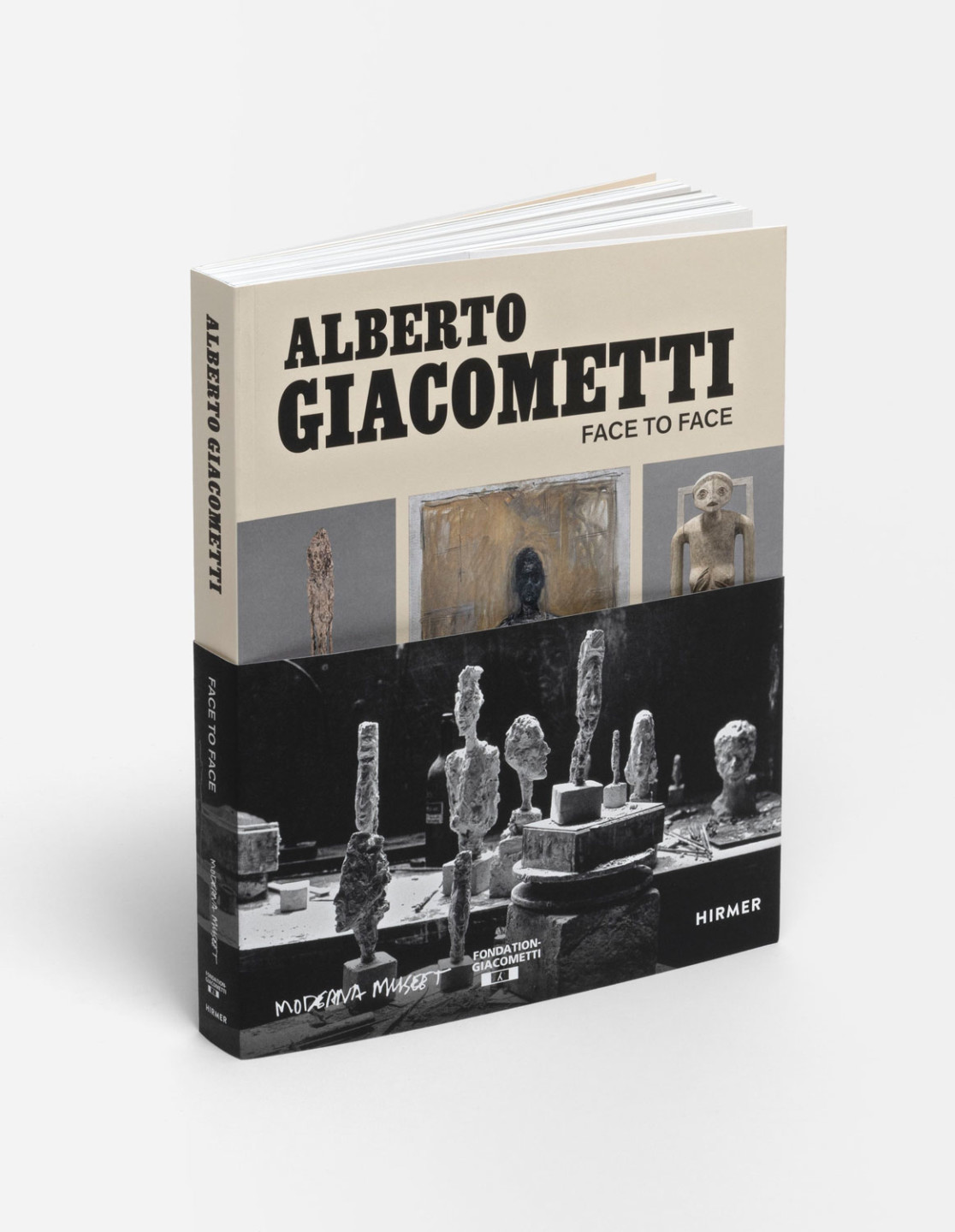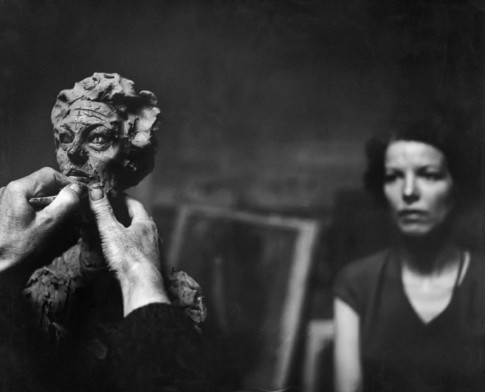
Alberto Giacometti, La Clairière, 1950. Collection Fondation Giacometti, Paris © Estate of Alberto Giacometti / Bildupphovsrätt 2020
FACE TO FACE
Text: Jo Widoff and Christian Alandete
From childhood, Alberto Giacometti copied images and artworks from books. It soon became an obsession and his large library of frayed art books is full of notes and drawings in the margins. Every scrap of paper, envelope, or receipt he had at hand was made to double as drawing paper. Giacometti copied art for the same reason he tried to copy reality: to try to understand what he saw. He spent his life trying to translate the sensation of seeing, first to find likenesses within the specific conditions of art and, later in his life, to understand why he had failed in this original task. Refusing to evade sculpture’s fundamental contradictions, he could spend days in front of the same face. Giacometti tried to make a head right like Cézanne had tried to get hold of an apple.
Seen in the harsh light of postwar existentialism, many commentators have portrayed Giacometti as a cloistered monument among the sculptures in the cell-like studio he kept from 1926. Simone de Beauvoir wrote of the artist: “Yesterday I visited his house; it is enough to frighten anyone. In a charming little forgotten garden, he has a studio, drowning in plaster, and he lives next to this in a kind of hangar, vast and cold, with neither furniture nor food,” and added, “his clothes, his hands and his thick, matted hair are covered with plaster.”[1]
This notion of the secluded artist-genius, indifferent to contemporary society and artistic trends and unfaltering in his art-making, is, of course, far from how the outspoken, curious, and politically engaged Giacometti conducted his daily life. By highlighting Giacometti’s relationship to three writers—Georges Bataille, Jean Genet, and Samuel Beckett, with whom the artist sustained lasting friendships—this exhibition and catalogue set out to trace their shared motives and how their dialogues, and the discourses that formed them, left their mark on Giacometti’s oeuvre.

Form
At eighteen years old, Giacometti left his childhood home in Stampa, Switzerland. After a grand tour of Italy, he landed in Paris in 1922 to study sculpture in Antoine Bourdelle’s class at the Académie de la Grande Chaumière. He settled definitively in the city in 1926 and soon drew attention from his peers. When showing a group of flattened sculptures of heads at Galerie Jeanne Bucher in 1929, Giacometti met the painter André Masson, who was then part of a dissident circle of writers and artists that had gathered around writer Georges Bataille after being excommunicated from poet André Breton’s surrealist group. Having already left behind academic realism, Giacometti’s work was then informed by his understanding of “primitivism”, a raging fashion in Paris at the time that involved blatantly appropriating forms from totems, sculptures, and objects brought back from the colonies.
Meeting Bataille, critic Carl Einstein, and writer Michel Leiris, editorial-board members of the short-lived avant-garde magazine ”Documents: Doctrines, Archéologie, Beaux-Arts, Ethnographie”, introduced Giacometti to a world of transgressive eroticism, human sacrifice, and prehistoric art (and later popular culture).[2] This subversive mix of high and low would inform Giacometti and many of the surrealists’ work, which was in turn placed side-by-side with other content in the magazine.
Bataille’s violently anti-aesthetic stance is discernible throughout ”Documents”, but perhaps most keenly felt in the “Critical Dictionary” closing each edition, which often undermined or sabotaged what had been proposed just a few pages earlier. Here, Bataille first introduced the concept of l’informe (formless), a philosophical operation meant to “bring things down in the world”, to quote Bataille’s short entry.[3] Removing art from its elevated platforms, defying both categorisation and stale idealism, Bataille instead celebrated art in a debased state. (After meeting Bataille, Giacometti began a series of works that forego conventional, vertical sculpture in favour of horizontal objects that embrace the lowly.)

”Documents” also picked up on Freud’s identification of “the aggressive factor of the libido”, and Bataille credited the father of psychoanalysis with laying bare the sexual instincts in the life impulse. Giacometti, aware of Freud’s thinking and sharing his notion of an eroticism based on transgression, sought to synthesise sex and violence in his art, giving free reign to his subconscious fantasies. The ambivalent “objects” he developed at the time generate feelings of frustration or depict sexual intercourse as a battle between the genders.
In one of the first reviews of Giacometti’s art, Leiris introduced the young sculptor as a maker of contemporary fetishes and declined to categorise his works as traditional sculptures, assigning them instead to an ethnographic setting.[4] Modern ethnography, as introduced by curator and writer Georges Henri Rivière, museum founder Paul Rivet, and anthropologist Marcel Griaule on adjacent pages of ”Documents”, contested notions of Western connoisseurship and insisted that artefacts be displayed and discussed in relation to their use value and cultural contexts.[5] By refusing aesthetic hierarchies and conventional categories, Bataille, Leiris and the ethnographers involved with ”Documents” used the objects and artworks of non-Western cultures as blunt tools in their struggle to overthrow Western idealism. Critic Rosalind Krauss, writing decades later, poignantly referred to this as the “hard” use of the “primitive” as opposed to the “soft” use of assimilating and aestheticising its forms.[6]
Space
After working from memory for some years, Giacometti once again returned to working in front of a model in the early 1950s and at the same time resumed painting with new vigour. His models were people close by: his wife Annette, his brother Diego, or artist and writer friends. Some sittings continued for weeks as he learned every detail of his subject’s face.
Playwright and poet Jean Genet and Giacometti met in 1954; their close friendship would result in several intense portraits and Genet’s ”The Studio of Alberto Giacometti” (L’Atelier d’Alberto Giacometti, 1958), one of the most celebrated texts on any artist’s work. Albeit different in character, Genet and Giacometti both steered themselves toward heightened moments in time and created piercing portraits of man on the fringes of existence. In ”The Studio of Alberto Giacometti” Genet, himself an outsider, returned to Giacometti’s frail yet strangely noble female figures, which he recognised as representations of the artist’s encounters in the brothels of Paris.
What Genet saw in the many female figures, violently carved into, cut, and slashed, was an indestructible core of isolation, of solitude and dignity, mirrored in his own writing project. (Some years later the same nervous, elongated figures would appear as illustrations on the cover of ”The Balcony”, (Le Balcon, 1956), the first play he wrote after meeting Alberto.) In his treatise on the artist, which also includes elements of recorded dialogue, Genet elevates Giacometti’s studio itself as part of his oeuvre.
In letters sent home to his family in Stampa, Giacometti would constantly complain about his rudimentary studio and the harsh conditions in which he lived and worked. But even though he had gained recognition and financial comfort by the late 1940s, he refused to leave, covering every inch of the studio walls with paintings. This ambiguous relation to space could be paired with how Genet returns repeatedly to cells and prisons in his other projects, such as the homoerotic love story ”A Song of Love” (Un chant d’amour, 1950, cat. 45). In this long-banned film—Genet’s first and only cinematic work—desire is confined to and plays out within the walls of claustrophobic prison cells; the need for human interaction is overwhelming, no matter the cost.

Reality
Giacometti sought an independent, self-sufficient space for art without losing the bodies that fascinated him in reality. On one of the few occasions that Samuel Beckett spoke about his own work, he, like Giacometti, referred to failure as inevitable, since “whatever is said is so far from the experience” that the words describe. This inadequacy in the face of reality was the main thrust of Beckett’s writing, which empties itself as much as possible and consciously denies the reader straightforward comparisons with the world of experiences.
Beckett and Giacometti became acquainted in the late 1930s and met often at night during the years leading up to the occupation of Paris. Their friendship intensified after the war, when both artists found a new aesthetic of reduction and an almost obsessive preoccupation with art’s relationship to reality. However, their actual collaboration is limited to the 1961 production of ”Waiting for Godot” (En attendant Godot, 1953) at Théâtre de l’Odéon in Paris. Beckett asked Giacometti to create the scenography for the play; together they decided on a forlorn sculpture of a tree as the only element on stage. Like Beckett’s strange band of vagabonds and nameless figures, Giacometti’s sculptures do not invite sympathy or sentimental, empathetic interpretations.
Instead they are at once intensely singular and invitingly universal. Isolated, dense, and concentrated, Beckett’s voices and Giacometti’s heads exist at the margins, cast out beyond time and space and reduced to pure existence. Compact talking heads recur in Beckett’s later texts, such as ”The Unnamable” (L’innommable, 1953) and the monologue ”Not I” (1972–75, cat. 67), in which the protagonist has been reduced to a standalone mouth, a voice that implacably speaks into the void. For Beckett it is the voice that remains when all the other signs of life have subsided. Giacometti was instead convinced that life’s essential presence is found in the gaze. Bit by bit he gave up the whole to become lost in the details, to concentrate all his efforts on the head and, toward the end of his life, to capture gazes themselves. Perhaps there and then a wholeness could finally emerge.
Discontinued Time
After the war, Giacometti’s thoughts and writings echo Beckett’s famed remark that “there is nothing to express, nothing with which to express . . . together with the obligation to express”, recognising both failure in front of an ever-evading reality and the need to persist.[7] When asked to talk about his work, Giacometti would lament how he could only speak indirectly of his sculptures. Yet he needed art to sort and to understand his experiences. He would often make drawings of the sculptures standing around the studio in a process of closing in on, or stumbling in front of, the notion of likeness—of learning and unlearning.[8] His writing, however, left him uncomfortable; he was a native speaker of Italian and was never satisfied with his mastery of French.
In the seminal text “The Dream, the Sphinx, and the Death of T.” (Le Rêve, le Sphinx et la mort de T.), published in ”Labyrinthe” in 1946, Giacometti touches on key themes in his art.[9] Asked to write a recollection of the death of his older friend Pieter Van Meurs, which he had witnessed when he was twenty years old, Giacometti struggled to connect the many interconnected events and proceedings that led to his understanding of the experience. Beginning with a surreal episode involving a spider, the text moves from the present to dreamscapes and vague recollections, from the temples at Paestrum to the closing of the Sphinx, the brothel where he was a regular customer. When faced with the predicament of how to order these events and fleeting impressions in a linear narrative, Giacometti instead imagined a circular disc enclosed by vertical pillars.[10] By placing himself in the middle of this schematic array of time and space, he could move freely between sensations: “Suddenly I had the feeling that all the events existed simultaneously around me. Time became horizontal and circular, and it was space at the same time.”[11] As a result, in “The Dream, the Sphinx, and the Death of T.”, Giacometti found a way to momentarily suspend time and imagine a self-sufficient room for art without losing the sensation of reality he so desired.

Giacometti’s stormy love affair with a young woman named Caroline late in life helped connect him to the changes happening in his adopted city.[12] When he was not leaving the studio in order to map ”Paris sans fin” (Paris without end) in Caroline’s car, Giacometti stayed in touch with the rest of the world by reading obsessively, including many newspapers in French, German, and Italian. Being a compulsory scribbler, he would cover the pages of the papers with heads, standing nudes, or scenes from the cafés in which he lingered. Grappling once again with the real, Giacometti worked assiduously to realise portrait busts and undertook a new transformation in his vision of reality. The stirring heads of this late period emerged from a magmatic base in which they were sometimes melted, bringing about a literal attempt to fuse the organic and the mineral. Giacometti thus wished to “take everything back to the foundations, as [he] saw beings and things—above all beings and their heads, their eyes at the horizon”.[13]
Notes
[1] Simone de Beauvoir, letter to Nelson Algren, 5 November 1947, in Simone de Beauvoir, ”A Transatlantic Love Affair: Letters to Nelson Algren”, New York: The New Press, 1999.
[2] After the fourth edition Variétés was added to the title to acknowledge that the revue had begun commissioning articles on popular culture.
[3] Georges Bataille, “Informe”, p. 17. Originally published in ”Documents” 7 (1929), p. 382.
[4] Michel Leiris, “Alberto Giacometti”, ”Documents” 4 (September 1929).
[5] The editorial board of ”Documents” consisted of an eclectic group of academics, museum curators, art historians, and writers. The magazine also coincided with the rise of a new generation of ethnographers and anthropologists in France. Among them was Georges Henri Rivière, then deputy director of the Musée d’ethnographie du Trocadéro. Rivière, at the time absorbed with a major rearrangement of the museum’s vast and diverse collections, used ”Documents” as a platform to launch his ideas on ethnographic theory and museology.
[6] Rosalind Krauss, ”The Originality of the Avant-Garde and Other Modernist Myths”, Cambridge, MA: MIT Press, 1986, p. 64.
[7] “The expression that there is nothing to express, nothing with which to express, nothing from which to express, no power to express, no desire to express, together with the obligation to express.” Samuel Beckett, in ”Proust and Three Dialogues, Samuel Beckett and Georges Duthuit”, London: John Calder, 1965. Originally published in ”Transition” 5 (1949).
[8] Responding to an inquiry in ”Minotaure”, Giacometti commented: “Once the object has been constructed, I have a tendency to rediscover in it, transformed and displaced, images, impressions, facts which have deeply moved me (often without knowing it).” Alberto Giacometti, ”Minotaure” 3–4, (12 December 1933), in Alberto Giacometti, ”Écrits. Articles, notes et entretiens”, Paris: Éditions Hermann, 2008.
[9] Alberto Giacometti, “Le Rêve, le Sphinx et la mort de T.”, pp. 82–87. Originally published in ”Labyrinthe” 22/23 (15 December 1946).
[10] The same glade-like form had often been the scene of recollections of violent childhood fantasies; Giacometti also deployed it when struggling with writing about the sculpture of Henri Laurens for ”Labyrinthe” in 1945. Alberto Giacometti, ”Écrits. Articles, notes et entretiens”, pp. 57–61.
[11] Alberto Giacometti, “Le Rêve, le Sphinx et la mort de T.”.
[12] At the time Giacometti met Caroline her real name was Yvonne Poiraudeau. She continuously changed her name and Caroline is to be considered her pseudonym.
[13] Alberto Giacometti, ”Écrits. Articles, notes et entretiens”, p. 569.
Buy the exhibition catalogue
This essay by Jo Widoff and Christian Alandetes is featured in the catalogue together with newly commissioned essays by Dawn Ades, Jesper Olsson and Agnès Vannouvong, and important historical texts by Georges Bataille, Jean Genet, and Samuel Beckett – with whom the artist sustained lasting friendships – and the artist himself.
The lavishly illustrated catalogue provides an overview extending from Giacometti’s early to his later works. 252 pages, 150 images.






